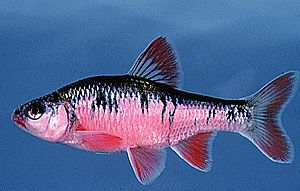Crescent shiner facts for kids
Quick facts for kids Crescent shiner |
|
|---|---|
 |
|
| Conservation status | |
| Scientific classification | |
| Synonyms | |
|
The crescent shiner (Luxilus cerasinus) is a type of ray-finned fish. This means it has fins supported by bony spines. It belongs to the Cyprinidae family. This family includes carps and minnows.
Contents
About the Crescent Shiner
The crescent shiner is a small freshwater fish. It gets its name from a crescent-shaped mark. This mark is often found behind its gill cover. It is a common fish in its native waters.
What It Looks Like
Crescent shiners are usually small. They grow to about 3 to 5 inches long. Their bodies are slender and silvery. They often have a dark stripe along their sides. During breeding season, males can become very colorful. They might show bright red or orange fins. Their bodies can also turn a reddish color.
Where It Lives
This fish lives in freshwater. You can find it in parts of Virginia and North Carolina. It lives in several river systems. These include the James River, Roanoke River, and Chowan River. It also lives in the New River and the upper Cape Fear River.
Preferred Habitat
Crescent shiners like clear, flowing water. They prefer rocky and sandy areas. You can find them in pools and runs. They live in headwaters, creeks, and small rivers. These areas usually have clean water. They also have plenty of places to hide.
Its Life and Habits
Crescent shiners are active fish. They often swim in small groups. They are important to their ecosystem. They are a food source for larger fish. They also help control insect populations.
What It Eats
Crescent shiners mostly eat small insects. They also eat tiny aquatic invertebrates. Sometimes they will eat plant matter. They find their food in the water. They also pick it off rocks and plants.
Reproduction
Crescent shiners usually spawn in spring. They lay their eggs over gravel or rocky bottoms. Sometimes they use old nests of other fish. The parents do not care for the young. The eggs hatch into tiny fish. These young fish grow quickly.
Conservation Status
The crescent shiner is listed as "Least Concern" (LC). This means its population is stable. It is not currently at risk of extinction. However, keeping its habitat clean is important. Pollution can harm fish populations. Protecting rivers helps all fish.
See also
 In Spanish: Luxilus cerasinus para niños
In Spanish: Luxilus cerasinus para niños


